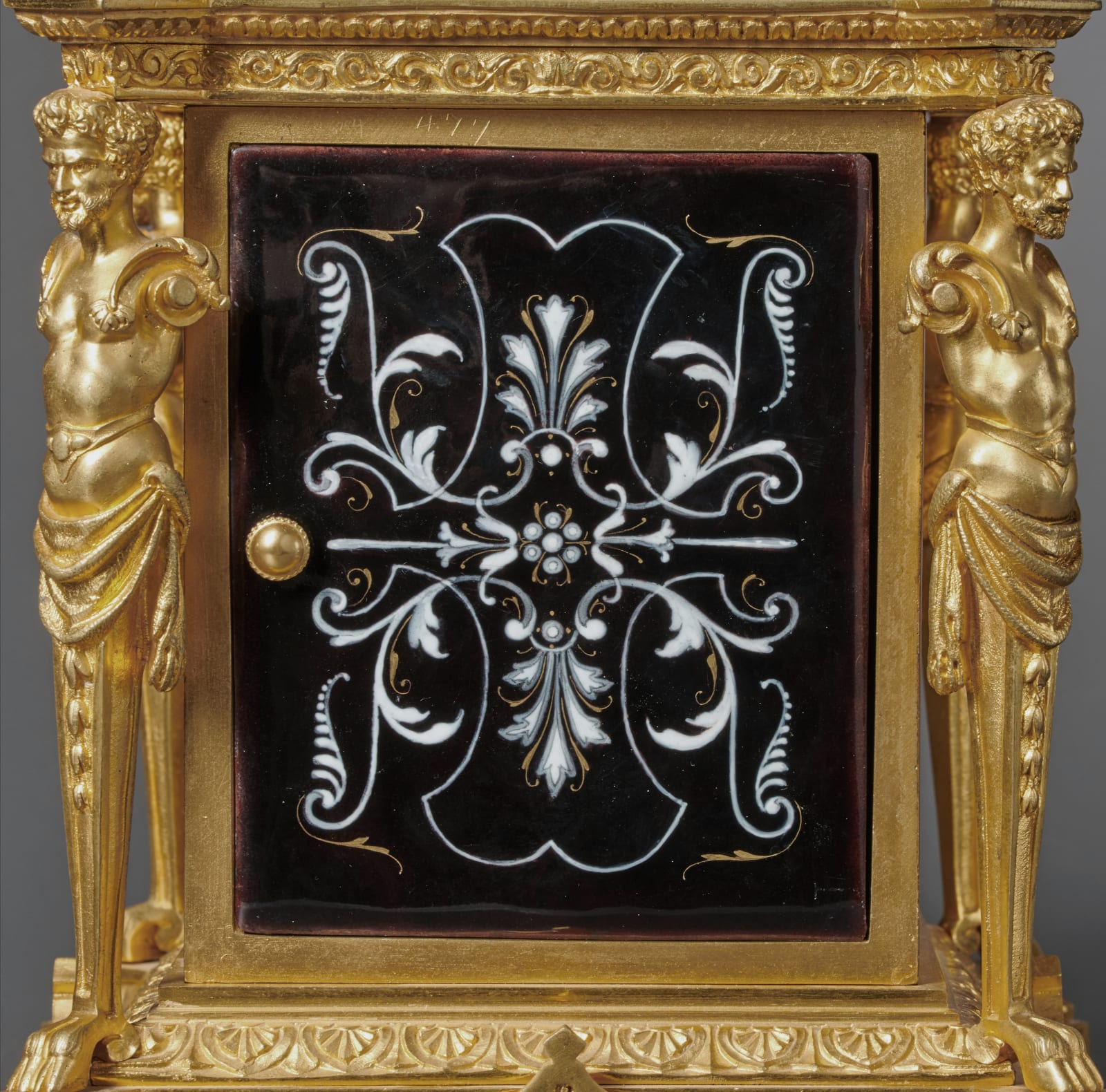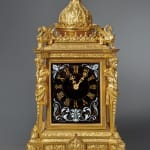Louis Fernier
Further images
A magnificent Napoleon III gilt bronze and Limoges enamel musical mantel clock with grande and petite sonnerie of eight day duration by Louis Fernier signed and numbered on the backplate LF Paris 2233. The champlevé enamel dial plate with a gilt hour ring enclosing Roman numerals on a black ground, with a pair of pierced gilt brass hands for the hours and minutes, with white and gilded foliate spandrels to the upper corners and similarly coloured foliate scrolls and a central anthemion crest below. The movement with lever escapement with grande and petite sonnerie and option for silence, with a subsidiary alarm dial marked 1-12 on the backplate and underneath the clock a sliding bar marked ‘Heures et quarts/silence/quarts seule’. The elaborate gilt bronze case of architectural form surmounted by an onion dome with foliate finial above a pair of pierced galleries, scrolled borders and winged griffins to the out-set corners above caryatid male terms with monopodia hoofed feet to the angles. The sides of the case with inset rectangular enamel panels, each signed with the monogram initials ‘S T’ for Théophile Soyer, one portraying a Renaissance courtier dressed in a plumed hat, red cloak and blue doublet, with a medallion around his neck and hand resting on a sword, standing in a rocky landscape with a castle in the distance. The other plaque with a Renaissance lady, wearing a turquoise blue hat with white feather, a long multi-coloured dress with green skirt, lace at her neck, holding a peacock feather fan and, like the courtier, stands in a landscape setting with a castle beyond. The base with a shaped apron on projecting angles mounted by paterae above tapering feet
Paris, date circa 1870
Height 31, width 17 cm, depth 17 cm.
This highly ornate clock reflects the late nineteenth century fascination with past historical styles. As here, the interest in former designs combines elements from each period to produce a new eclectic style that includes aspects from the Renaissance, Régence and Neo-classical styles. For instance, the male monopodia terms look back to the early eighteenth century, when they appeared as gilt bronze mounts on both Régence clock cases and pieces of furniture. The foliate scrolled grisaille enamel decoration around the dial also emulates the same period when such designs featured in Boulle marquetry. In contrast the scrolled borders and paterae are more typical of Neo-classicism while the enamel Limoges panels at either side look back to the Renaissance, portraying a royal or aristocratic couple who would not have been out of place in the court of Francis I. Griffins have featured in art across the centuries so do not necessarily belong to a specific period. Finally it should be mentioned that the surmounting dome as well as the pierced galleries below look more Oriental that European.
The Limoges enamel dial and side panels are of the highest quality. Both side panels are signed with a monogram to include an ‘S’ entwined around the letter ‘T’ for Théophile Soyer (1853 - 1940).
Another pair of Limoges plaques from the same period, portraying a Renaissance lady and gentleman on horseback, are similarly signed but also include the letter ‘P’ (Skinners, Boston, 13th October 2017, lot 266). The use of Limoges enamel decoration for mantel and carriage clocks was popular from about 1870-1910. As here they were nearly always on a black but occasionally on a dark blue ground, with the dial plate in particular reflecting Limoges’s preference in the fifteenth and sixteenth centuries toward grisaille designs. Again as here many Limoges panels for clocks often featured figures in historical costumes.
Given the quality of the bronze work, the sumptuous design and fine enamel work, this clock may well have been an exhibition piece. The movement was made by Louis Fernier, who operated from both Besançon and Paris and also worked with his brother under the name Louis Fernier et Frères. In all probability Louis Fernier was Louis-Joseph Fernier who was born in Besançon in 1815 and died in the same town in 1879. In addition to being an expert clockmaker he played a strong role in politics, standing as deputy mayor of Besançon in 1871. Tardy also notes that Louis Fernier was the successor of Cressier of Besançon and also lists Maxime Fernier who was active in 1875 and died in 1922. The later may well have been one of the two sons of Louis Fernier who distinguished themselves as pupils of the Ecole d’Horlogerie de Besançon (as noted in ‘Mémoires La Societé d’Emulation du Doubs’, 1869). The firm made carriage clocks, mantel clocks and also watches, with Louis Fernier winning a second class medal at the Exposition Universelle in 1855. Louis Fernier is perhaps best known as a maker of high quality carriage clocks, which is interesting since the present clock is fitted with a typical French carriage clock movement, but as it has a domed top instead of a carrying handle, it is best described as a mantel rather than carriage clock.







